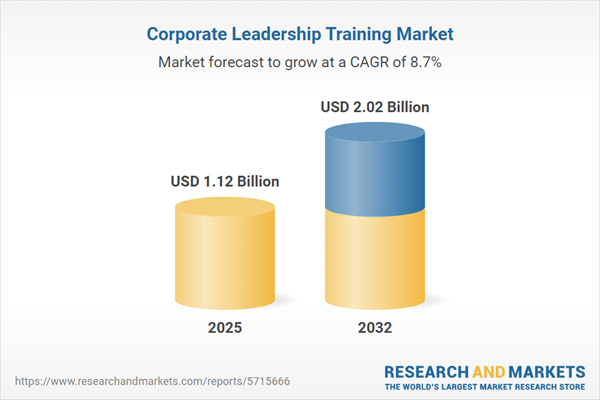Speak directly to the analyst to clarify any post sales queries you may have.
Amid rapidly changing business environments, executive leadership training has become an integral strategy for organizations focused on cultivating agile leaders and sustaining enterprise competitiveness. This report provides senior decision-makers with comprehensive market intelligence to prioritize leadership development and strategic talent management.
Market Snapshot: Executive Leadership Training Market Size and Growth
The executive leadership training market is projected to reach USD 1.03 billion in 2024 and increase to USD 1.12 billion by 2025, reflecting a compound annual growth rate of 8.67% through 2032. This growth is driven by the accelerated integration of digital transformation, evolving workforce demands, and the widespread adoption of technology-enabled learning platforms. Adaptive training models are being embraced as core elements to strengthen organizational resilience and deliver business objectives through guided talent strategies.
Scope & Segmentation in the Corporate Leadership Training Market
This report delivers a thorough segmentation to help leadership teams make informed decisions and leverage executive leadership training for maximum organizational impact. Strategic segmentation covers the following dimensions:
- Delivery Mode: Blended, in-person, online, self-directed, and virtual classroom training options support diverse workforce setups and hybrid learning strategies.
- Organization Size: Customizable for large enterprises, micro-businesses, and SMEs, solutions are calibrated to scale and optimize resource deployment.
- Industry Vertical: Addresses leadership needs unique to BFSI, healthcare, IT and telecom, and manufacturing, providing sector-specific development approaches.
- Training Topic: Focuses on areas such as emerging leadership, executive readiness, functional upskilling, and development for middle management, ensuring well-rounded capability building.
- Participant Level: Offers tailored training pathways for new managers, mid-career professionals, and senior leaders, facilitating alignment with individual career milestones.
- Deployment Mode: Enables in-house, private, and public program delivery to align with varied organizational structures and operational needs.
- Geographic Segmentation: Analyzes the Americas, EMEA, and Asia-Pacific, highlighting the evolution of market maturity, regional preferences, and challenges to adoption.
- Technology Integration: Integrates artificial intelligence, analytics, immersive simulations, and cloud-based platforms to enhance engagement, provide personalized learning paths, and achieve measurable results.
- Key Players: Profiles Franklin Covey Co., Dale Carnegie & Associates, Korn Ferry, Mercer, and DDI to illustrate leading practices and service diversity across the competitive market.
Key Takeaways: Strategic Insights for Senior Decision-Makers
- Digital and hybrid leadership development programs now allow wider access and consistent implementation regardless of geographic location, supporting global talent strategies.
- Modern leadership curricula increasingly prioritize adaptive skills and resilience to organizational change, supporting evolving requirements for diversity, equity, and inclusion.
- Data-driven analytics are reshaping how organizations measure the impact of executive training, linking program outcomes with improved engagement and talent retention.
- Cultural and regional distinctions significantly shape the structure and delivery of leadership solutions, ensuring initiatives remain relevant in both mature and emerging markets.
- Leveraging multiple external training vendors allows organizations to fine-tune focus and flexibility in line with strategic technology adoption and evolving budget priorities.
Tariff Impact: Budget and Vendor Considerations
Recent updates in U.S. tariff regulations are accelerating the transition to digital and cloud-based models for executive leadership training. Organizations increasingly look to local and regional providers, gaining operational resilience and reduced reliance on international vendors. Investments in domestic expertise and advanced digital infrastructure are also helping organizations maintain the continuity of leadership programs during regulatory change or periods of economic uncertainty.
Methodology & Data Sources
This market research draws from rigorous secondary analysis and expert interviews with C-suite leaders, seasoned learning professionals, and key industry providers. Validation by subject matter experts ensures accurate segmentation and actionable insights for senior executive teams and key stakeholders.
Why This Report Matters
- Empowers leaders with detailed market intelligence to inform investments and support evidence-based executive planning for leadership development.
- Enables benchmarking and assessment of existing programs, fostering stronger organizational cohesion and supporting improved talent outcomes.
- Provides timely insights into changing market dynamics and emerging technologies to help organizations refine their cross-regional leadership strategies.
Conclusion
A strategic, adaptable approach to executive leadership training positions organizations to anticipate ongoing change and outperform evolving business challenges. Focused leadership development supports organizational agility, continuity, and future-focused success.
Additional Product Information:
- Purchase of this report includes 1 year online access with quarterly updates.
- This report can be updated on request. Please contact our Customer Experience team using the Ask a Question widget on our website.
Table of Contents
3. Executive Summary
4. Market Overview
7. Cumulative Impact of Artificial Intelligence 2025
List of Figures
Samples

LOADING...
Companies Mentioned
The key companies profiled in this Corporate Leadership Training market report include:- Franklin Covey Co.
- Dale Carnegie & Associates, Inc.
- Korn Ferry Holdings, Inc.
- Willis Towers Watson Public Limited Company
- Mercer LLC
- DDI, Inc.
- GP Strategies Corporation
- Skillsoft Ltd.
- Center for Creative Leadership, Inc.
- Wilson Learning Worldwide, Inc.
Table Information
| Report Attribute | Details |
|---|---|
| No. of Pages | 186 |
| Published | October 2025 |
| Forecast Period | 2025 - 2032 |
| Estimated Market Value ( USD | $ 1.12 Billion |
| Forecasted Market Value ( USD | $ 2.02 Billion |
| Compound Annual Growth Rate | 8.6% |
| Regions Covered | Global |
| No. of Companies Mentioned | 11 |









